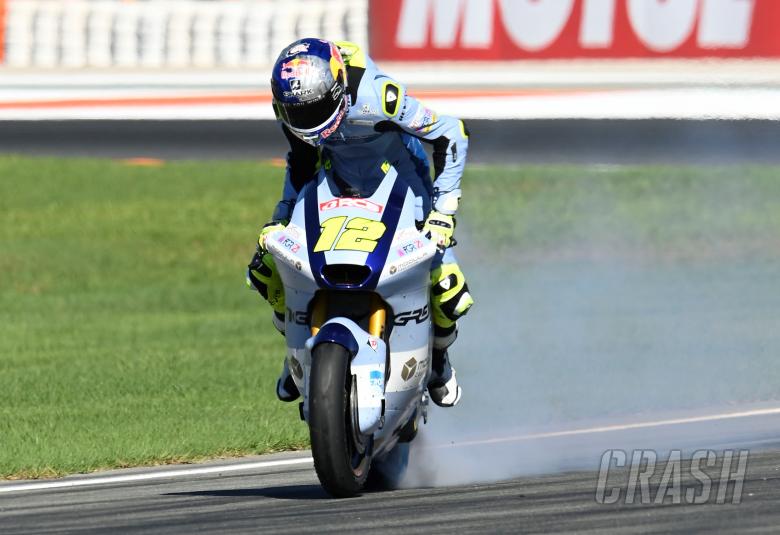‘I'll fight tooth and nail not to have traction control in Moto2!’


The aim was to better prepare intermediate-class riders for the kind of advanced electronics they would need to master in MotoGP.
But that doesn’t mean Moto2 got access to all the electronic gadgets possible from the ECU.
While a variety of pre-set torque maps and engine braking could now be chosen, a conscious decision was taken not to provide Moto2 with the most well-known electronic aid of all; traction control.
- Triumph: Electric power? ‘Let’s not kid ourselves...’
- Exclusive: Front ride-height ban ‘correct thing to do’ - rear next?
- Triumph ‘focus’ on Moto2, MotoGP ‘a whole different ball game’
Part of the reason was to limit costs and complexity, with MotoGP’s Director of Technology Corrado Cecchinelli telling Crash.net at the time: “Traction control is one of the most famous and effective strategies but unfortunately it's one of the most difficult to tune.”
Cecchinelli added: "We didn't introduce traction control because we count on proper engine tuning to make it rideable and we don’t want to add too much complication from the beginning.
“[But] it's one of the strategies we could introduce at some time [in the future] if needed, which means if it's needed on track and if it's needed in the rider training process, as one more thing to learn before moving up to MotoGP.”
But as Triumph prepares for its fifth season of Moto2 in 2023, the British manufacturer hopes that ‘TC’ continues to stay away.
“For me, no,” said Triumph Chief Product Officer Steve Sargent of adding traction control.
‘It's about the rider's wrist’
ExternPro Technical Director Trevor Morris, whose company prepares and maintains the 765cc engines, remains strongly opposed.
“Absolutely no! I will fight tooth and nail not to have traction control!” Morris told Crash.net.
“The whole concept of Moto2 really is as a feeder class - and you just have to look at the MotoGP field, [almost] every single one of them [except Jack Miller] has learnt their trade on a Moto2 bike.
“It’s about the [rider’s] wrist. So basically the amount of power that we’ve got, the characteristic of the engine and how the bike is performing is not just a guess, it's actually been worked out: This is what we need to make the bike [feel] very similar to a MotoGP bike.
“For example, I spoke with numerous guys, including Bezzecchi. And he said to me, ‘when I went from Moto3 to Moto2, I really struggled’. But going from the Triumph era of Moto2 to MotoGP he said was very easy.
“Basically, the ECU that we have now is identical to a MotoGP ECU,” Morris confirmed. “And it can do exactly the same as a MotoGP bike if we wanted to, but that's not the point.
“What we're doing has to be firstly, cost-effective and secondly, what's more important: That a rider learns how to deal with more electronics or learns how to race a motorbike to its maximum? For me, it’s racing the bike to the maximum.
“Bezzecchi said the characteristic of the Moto2 bike is very similar to the Ducati. Just with less power.
“With the Honda [Moto2 engine] it was completely different. But once we got to the spec we have now, with the Triumph engine and Marelli ECU, it felt like a racing motorcycle.
“With all electronics on the MotoGP bike, Remy [Gardner] actually said [accelerating in] first, second and third gear is boring. You just hit it. But if you do that on a Moto2, it will spit you off!
“You have to really play [with the throttle in Moto2] and have this finesse to get the maximum out of it. And for me, that's the beauty of a racing motorcycle.”
‘People want good close racing’
Rather than electronics, one of the biggest performance differences highlighted by riders stepping up to the premier class is tyres, which are provided by Dunlop in Moto2 and Michelin in MotoGP.
Sargent insisted there is no pressure from Triumph’s side to increase tyre performance, adding that the existing rubber is good enough to set new lap records (and nip at the heels of the slower MotoGP riders).
“I think the main thing people want is good close racing. And reliability as well,” Sargent said. “So I think it's more important that the tyres perform consistently and that everybody's on a level playing field.
“Of course, it's nice to break lap records, and we’ve broken a lot of lap records, so we're happy with our relationship with Dunlop and I personally think they do a really good job.”



